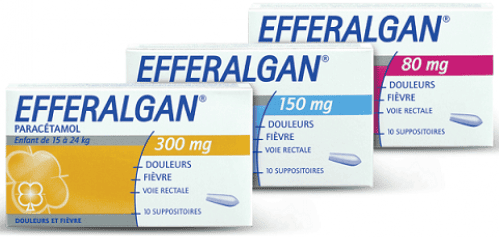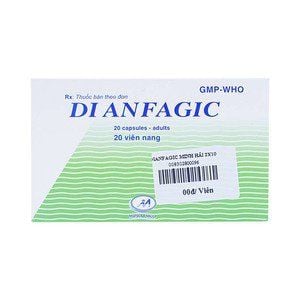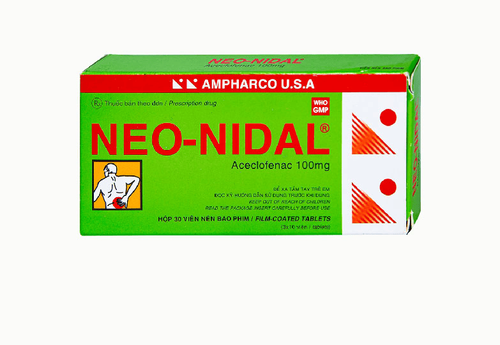This is an automatically translated article.
Dinalvic drug includes two main active ingredients: Paracetamol and Tramadol or Dextropropoxyphene. The drug is effective in treating mild to severe pain.
1. Uses of the drug Dinalvic
Dinalvic drug consists of 2 main ingredients, that is:
Acetaminophen, also known by another more common name, Paracetamol. This ingredient belongs to the group of NSAID anti-inflammatory pain relievers, effective in reducing fever and pain, which is absorbed very quickly from the gastrointestinal tract. The analgesic mechanism of Paracetamol is through its ability to selectively inhibit the COX-2 receptor, which inhibits Prostaglandin E2 to reduce thermogenesis to help reduce fever and at the same time inhibits the synthesis of prostaglandins that cause pain, thereby helping to reduce pain. In addition, Paracetamol has little effect on COX-1, so it reduces gastrointestinal toxicity than other NSAIDs. Dextropropoxyphene or Tramadol: Belongs to the group of central opioid analgesics, structurally related to methadone, which are effective in reducing pain. This ingredient is often combined with Paracetamol or Aspirin to enhance pain relief. The mechanism of action of this ingredient is attached to the Opioid receptor, which inhibits the pain center in the central nervous system, thereby reducing pain quickly and effectively, but also has the effect of causing drug dependence if used for a long time or incorrectly. amount. Both active ingredients in Dinalvic are mild to moderate pain relievers, but when combined they work synergistically to increase the analgesic effect of each drug to help you reduce severe pain and reduce unwanted effects. want or complications later.

Thuốc Dinalvic được dùng điều trị các cơn đau từ nhẹ đến nặng
2. Indications for the use of Dinalvic
Dinalvic is usually indicated for the treatment of moderate to severe pain such as:
Headache; Muscle pain; toothache; Chest pain; Low back pain; Body aches and pains; Nerve pain; Pain after trauma, surgery; Persistent pain in cancers; Unresponsive to other peripheral analgesics.
3. Usage and dosage of Dinalvic drug
3.1. Dosage and administration of the drug Dinalvic dosage can be adjusted according to the pain level and response ability of each person, treating doctors will prioritize choosing the lowest effective dose. The recommended initial dose of Dinalvic for pain relief in adults and children over 16 years of age is:
2 Dinalvic VPC tablets/time, the time interval between two tablets is approximately 4-6 hours. No more than 8 pills/day. No dose adjustment is required in the elderly. For patients with moderate renal impairment, with creatinine clearance between 10-30mL/min, the interval between 2 doses should be increased to 12 hours. In cases of severe renal impairment (creatinine clearance < 10 mL/min) this drug should not be used in the treatment of the disease. In patients with hepatic impairment, the dose interval should also be considered according to individual response. . Do not use Dinalvic for people with severe liver failure.
Children between 12 and 16 years old only use according to the dosage prescribed by the doctor. Dinalvic should not be given to children under 12 years of age because its safety and effectiveness have not been established.

Người bệnh nên dùng thuốc Dinalvic VPC đúng liều lượng
3.2. Cases of drug overdose: Cases, overdose of Dinalvic VPC can be manifested by clinical signs of poisoning with paracetamol, tramadol or both of these components.
Paracetamol poisoning In the first 24 hours, there are usually signs such as pallor, nausea, vomiting, loss of appetite and abdominal pain. At the same time, symptoms of liver damage may appear and become more apparent after about 48-72 hours, especially in people who have taken more than 7.5 to 10 grams of paracetamol. Severe poisoning can progress to hepatic encephalopathy, deep coma and even life-threatening.
Tramadol poisoning Clinical symptoms are similar to those of other centrally acting analgesics (opioids). Specifically, people with poisoning may experience signs including coma, vomiting, cardiovascular collapse, impaired consciousness. More serious can occur deep coma, convulsions and respiratory depression, even circulatory arrest.
To ensure safety in case of emergency or drug overdose, you need to go to the nearest local Health station. In addition, you also need to record and bring a list of all medications you are taking, including prescription drugs, over-the-counter medicines, herbal medicines and supplements.
3.3. If you forget to take a dose of Dinalvic, take it as soon as you remember. You should then wait for 4-6 hours before taking your next dose. Do not take the medicine with a double dose of the prescribed dose, to ensure that the total amount of medicine you take each day does not exceed 8 Dinalvic tablets.
4. Contraindications of the drug Dinalvic
Contraindicated to use Dinalvic drug in the following cases:
Sensitivity or hypersensitivity to paracetamol, tramadol or any of its ingredients. Acute intoxication with alcoholic beverages such as alcohol, sleeping pills, narcotics, CNS depressants, opioids or psychotropic drugs. Are taking MAO inhibitors concurrently to treat mental illness, depression, or have used them within the last 2 weeks. Have severe asthma or breathing problems. People with epilepsy who are not adequately controlled by treatment. Liver failure, severe renal failure. Undergoing drug treatment. Children 12 years and under. At the same time, Dinalvic also needs to be used with caution in the following cases:
People who are dependent on opioid drugs. Increased intracranial pressure or head trauma. Shortness of breath, respiratory dysfunction, history of sleep apnea syndrome. Mental illness such as depression, decreased consciousness for unknown reasons. Decreased liver and kidney function. Seizures or risk of convulsions. Dinalvic may cause drowsiness, dizziness, and cognitive impairment in some people. You should refrain from driving or operating machinery or participating in activities that require alertness until you know how Dinalvic affects you.
5. Undesirable effects of the drug Dinalvic
During use, Dinalvic will be able to experience a lot of side effects depending on the tolerability of the drug and the location of each person. Undesirable effects are also a combination of the two components above, however, Paracetamol is quite safe with few unwanted effects at therapeutic doses, while with central Opioid analgesics, it has addictive effects. The duration of taking Dinalvic and the dose of the drug will be proportional to the ability to cause addiction.
In addition, the drug has a number of other side effects that occur most often on the central nervous system and the digestive system. The most common adverse effects are nausea, vomiting, fatigue, dizziness, drowsiness.
Some of the following adverse effects also occur, but with less frequency:
Body condition: fatigue, weakness, strong emotions. Central and peripheral nervous system: headache, tremor. Digestive system: abdominal pain, digestive disorders: constipation, diarrhea, dyspepsia, flatulence, dry mouth, vomiting. Psychiatric disorders: excessive anxiety, confusion, agitation, insomnia, restlessness. Skin and skin dependent parts: rash, rash, increased sweating.
6. Dinalvic drug interactions
Interactions with MAO inhibitors and serotonin reuptake inhibitors: Concomitant use with MAO inhibitors or serotonin reuptake inhibitors may increase the risk of adverse effects. Undesirable effects on the body include seizures and serotonin syndrome.
Interactions with carbamazepine: Concomitant use of tramadol hydrochloride with carbamazepine increases the metabolism of tramadol. The analgesic effect of tramadol in Dinalvic may be reduced in people taking it with carbamazepine.
Interactions with quinidine: Tramadol in the drug is metabolized to M1 (the active metabolite) by CYP2D6. Taking a combination of drugs of the quinidine group with tramadol will increase the concentration of tramadol. The clinical outcome of the interaction between these two drugs has not yet been studied.
Interactions with substances of the warfarin group: As a medical rule, it is necessary to periodically evaluate the peripheral blood clotting time when Dinalvic is co-administered with these drugs due to the recording of INR (international normalized ratio - index). international normal) increased in some concurrent users.
Interactions with CYP2D6 Inhibitors: Laboratory studies have shown drug interactions on the microsomes of the human liver that indicate that co-administration with CYP2D6 inhibitors such as fluoxetine, paroxetine and amitriptyline may be limited inhibit the metabolism of tramadol.
Interaction with cimetidine: Concomitant use of Dinalvic with cimetidine does not change the pharmacokinetics of tramadol in clinical terms.

Thuốc dinalvic có thể tương tác với một số thuốc khi kết hợp sai cách
7. Notes on drug use
Caution when using the drug because of the risk of convulsions when tramadol is used concurrently with SSRIs (serotonin reuptake inhibitors), TCAs (tricyclic compounds), Opioids, MAOIs, tranquilizers or drugs that lower the seizure threshold; or in cases of epilepsy, who have a history of convulsions, or are at risk of convulsions. Use caution when using the drug because of the risk of respiratory depression in people at risk of respiratory failure; taking high doses of tramadol with anesthetics, anesthetics, alcoholic beverages such as alcohol. Caution should be exercised when co-administering with central nervous system depressants such as alcohol, opioids, anesthetics, anesthetics, hypnotics and sedatives. Use with caution in people with a history of increased intracranial pressure or head trauma. Use caution when using for people with a history of or are addicted to opiates, because it can cause relapse. Use with caution in chronic alcoholics because of the possible increased risk of hepatotoxicity. The use of Naloxone in the treatment of an overdose of Tramadol may increase the risk of convulsions. For individuals with creatinine clearance less than 30 ml/min, a dose of no more than 2 tablets is recommended every 12 hours. Use with caution in people with severe liver failure. Do not take more medicine than prescribed by your doctor. Do not take with other medicines containing paracetamol or tramadol. The drug Dinalvic includes two main active ingredients: Paracetamol and Tramadol or Dextropropoxyphene. The drug is effective in treating mild to severe pain. To ensure effective use and avoid unwanted side effects, patients should carefully read the instructions or follow the instructions of the doctor or pharmacist.
Follow Vinmec International General Hospital website to get more health, nutrition and beauty information to protect the health of yourself and your loved ones in your family.
Please dial HOTLINE for more information or register for an appointment HERE. Download MyVinmec app to make appointments faster and to manage your bookings easily.













